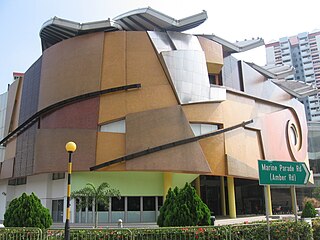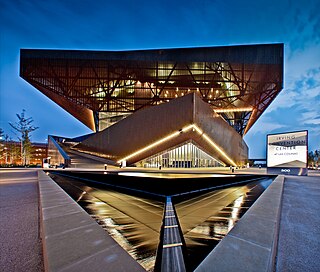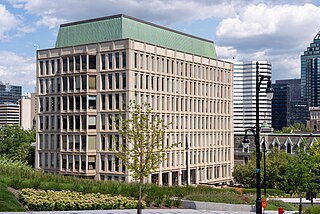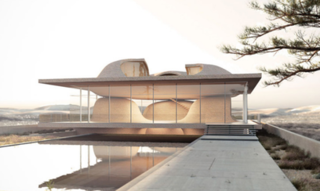
A terrace, terraced house (UK), or townhouse (US) is a type of medium-density housing which first started in 16th century Europe with a row of joined houses sharing side walls. In the United States and Canada these are sometimes known as row houses or row homes.

The Royal Crescent is a row of 30 terraced houses laid out in a sweeping crescent in the city of Bath, England. Designed by the architect John Wood, the Younger, and built between 1767 and 1774, it is among the greatest examples of Georgian architecture to be found in the United Kingdom and is a Grade I listed building. Although some changes have been made to the various interiors over the years, the Georgian stone facade remains much as it was when first built.

Biltmore Estate is a historic house museum and tourist attraction in Asheville, North Carolina, United States. The main residence, Biltmore House, is a Châteauesque-style mansion built for George Washington Vanderbilt II between 1889 and 1895 and is the largest privately owned house in the United States, at 178,926 sq ft (16,622.8 m2) of floor space and 135,280 sq ft (12,568 m2) of living area. Still owned by George Vanderbilt's descendants, it remains one of the most prominent examples of Gilded Age mansions.

The Ward W. Willits House is a home designed by architect Frank Lloyd Wright. Designed in 1901, the Willits house is considered one of the first of the great Prairie School houses. Built in the Chicago suburb of Highland Park, Illinois, the house presents a symmetrical facade to the street. One of the more interesting points about the structure is Wright's ability to seamlessly combine architecture with nature. The plan is a cruciate with four wings extending out from a central fireplace. In addition to stained-glass windows and wooden screens that divide rooms, Wright also designed the furniture for the house.

The Peace Hotel is a hotel on The Bund in Shanghai, China, which overlooks the surrounding areas. The hotel has two different buildings. The Sassoon House, originally housed the Cathay Hotel and is today the Fairmont Peace Hotel run by Fairmont Hotels and Resorts of Canada. The South Building was built as the Palace Hotel and is today a residence and studio for artists, known as The Swatch Art Peace Hotel. The two buildings both face the Bund, but are divided by Nanjing Road.

The Brisbane Showgrounds is a multi-purpose venue located in Bowen Hills, Brisbane. Established in 1875, it hosts more than 250 events each year, the largest being the Royal Queensland Show (Ekka).

Buda Castle, formerly also called the Royal Palace and the Royal Castle, is the historical castle and palace complex of the Hungarian kings in Budapest. First completed in 1265, the Baroque palace that occupies most of the site today was built between 1749 and 1769, severely damaged during the Siege of Budapest in World War II, and rebuilt in a simplified Baroque style during the state communist era. Presently, it houses the Hungarian National Gallery, the Budapest Historical Museum, and the National Széchényi Library.

Muswellbrook railway station is a heritage-listed railway station located on the Main Northern line in Muswellbrook, in the Muswellbrook Shire local government area of New South Wales, Australia. The station serves the town of Muswellbrook and was designed by John Whitton, the Chief Engineer of NSW Railways. It is also known as Muswellbrook Railway Station and yard group and Musclebrook Railway Station. The property was added to the New South Wales State Heritage Register on 2 April 1999.

Precast concrete is a construction product produced by casting concrete in a reusable mold or "form" which is then cured in a controlled environment, transported to the construction site and maneuvered into place; examples include precast beams, and wall panels, floors, roofs, and piles. In contrast, cast-in-place concrete is poured into site-specific forms and cured on site.

Marine Parade Community Building was a community centre located at 278 Marine Parade Road, Singapore. Opened on 6 March 2000, it houses the formerly separate Marine Parade Community Centre and Marine Parade Public Library, as well as a performing arts group, The Necessary Stage. Designed by William Lim Associates, one of the distinguishing features of the postmodern building is the mural cladding called the "Texturefulness of Life", the largest piece of installation art in Singapore. It was demolished in 2022 and is being rebuilt.

The Cube is a 24-storey mixed-use development in the centre of Birmingham, England. Designed by Ken Shuttleworth of Make Architects, it contains 244 flats, 111,500 square feet (10,359 m2) of offices, shops, a hotel and a 'skyline' restaurant. It is the final phase of The Mailbox development.

The Irving Convention Center is a 275,000 sq ft (25,500 m2) facility on a 40 acres (16 ha) tract in Las Colinas Urban Center in Irving, Texas. Opened in January 2011, the convention center and the adjoining mixed use entertainment district are bordered on the west by Highway 114, on the east by Las Colinas Boulevard, on the north by Spur 348/Northwest Highway, and to the south by Fuller Drive. The building is recognized for its unique architecture and vertical design.

Lady Bowen Hospital is a heritage-listed former maternity hospital and now social housing and office complex at 497–535 Wickham Terrace, Spring Hill, City of Brisbane, Queensland, Australia. It was designed by John H. Buckeridge and built from 1889 to 1890 by John Quinn. It was also known as Brisbane Lying-In Hospital and the Lady Bowen Hostel. It was added to the Queensland Heritage Register on 23 April 1999. The complex consists of the former hospital and nurses' quarters buildings; a third building which had been contained in the heritage listing was demolished c. 2005–2008.

The Iran Mall is a shopping mall in Iran. With 1,950,000 m2 (21,000,000 sq ft), it is the world's largest shopping mall, beating the previous record holder The Dubai Mall. It is located in northwest Tehran, Iran, by Chitgar Lake.

The Edificio del Seguro Médico is a commercial building in El Vedado, Havana. Built between 1955 and 1958, it was designed as a mixed use building for apartments and offices for the headquarters of the National Medical Insurance Company by Antonio Quintana Simonetti.
The Embassy of Sweden in Tehran is Sweden's diplomatic mission in Iran. The mission consists of an embassy, a number of Swedes sent by the Ministry of Foreign Affairs and local employees. Mathias Otterstedt has been ambassador since 2023.

The Stephen Leacock Building, also known simply as the Leacock Building, is a building located at 855 Sherbrooke Street West, on the McGill University downtown campus in Montreal, Quebec. The building was named after Stephen Leacock, a well-known Canadian humorist and author, and Professor of Economics at McGill from 1901 to 1944. Built between 1962 and 1965 by the Montreal architectural firm Arcop, the Leacock Building's purpose was to accommodate the growing number of students at McGill, particularly in the Faculty of Arts which had outgrown its ancestral home, the Arts Building.

Alireza Taghaboni, is an Iranian architect based in Tehran, Iran. He is, a practicing architect since 2004, founded Next Office in 2009. He has designed contemporary buildings in Tehran such as the Sharifi-ha House and Cedrus Residential. He is on the faculty at the Center for Contemporary Architecture in Tehran.

Guyim Vault House is a two level residential concept-home which features dome shapes which utilize Chahartaq design elements. The home uses cubed sections which are fashioned in the shape of domes to create separate areas. The home was a winner of the "House Future Project" award at the 2018 World Architecture Festival.

Cedrus Residential also known as the Cedrus Dream Garden Tower is a residential building in Tehran. The contemporary building is located in the wealthy area of Sa'adat Abad and features a facade of staggered and walled balconies. In 2019 the building won first prize at the World Architecture Festival in the "Completed Building Housing category".




















